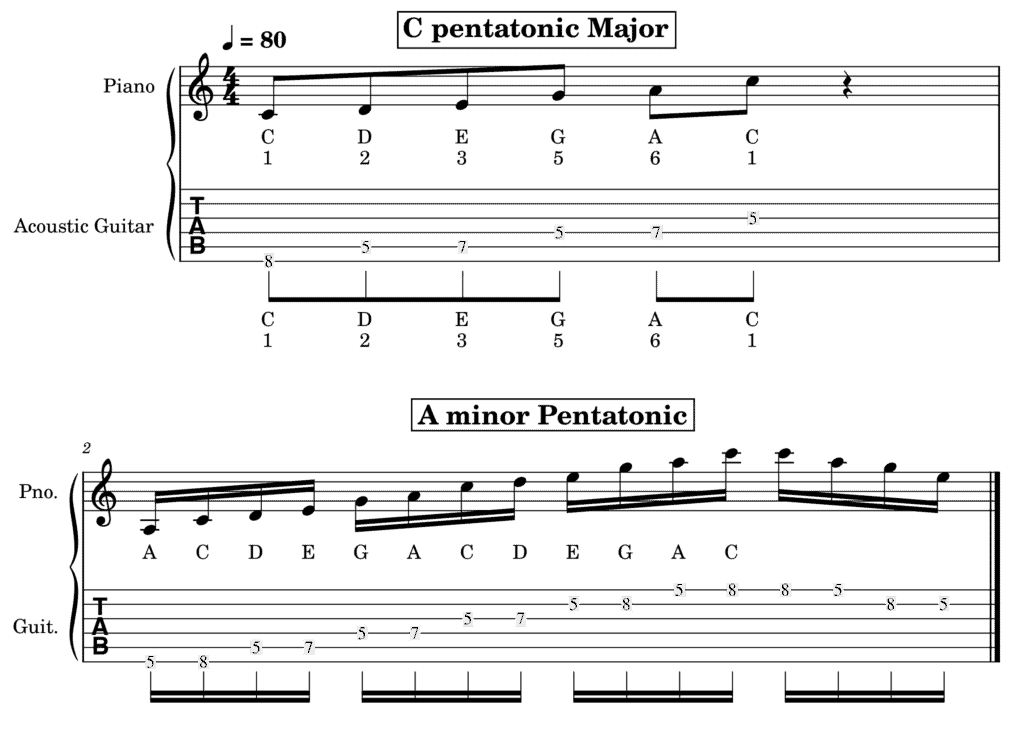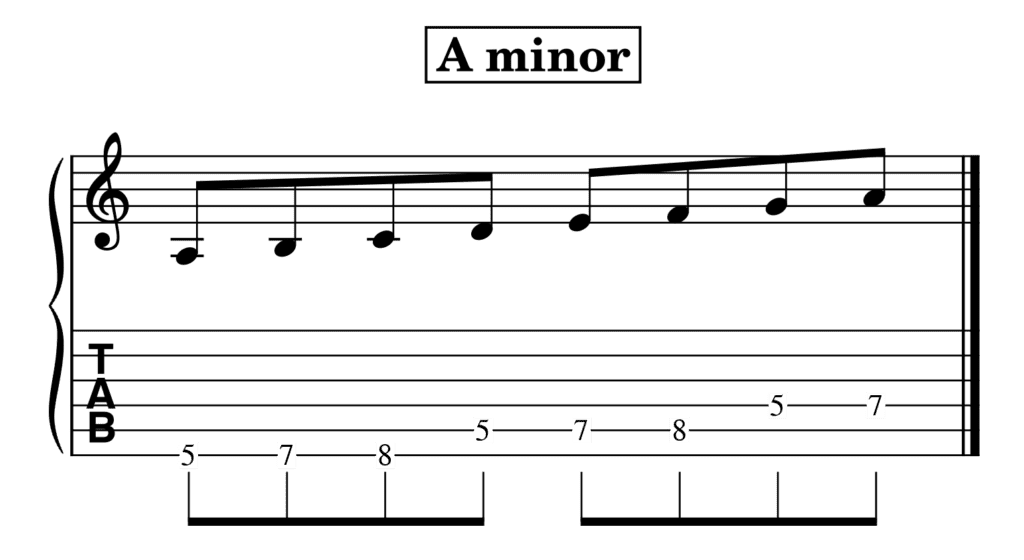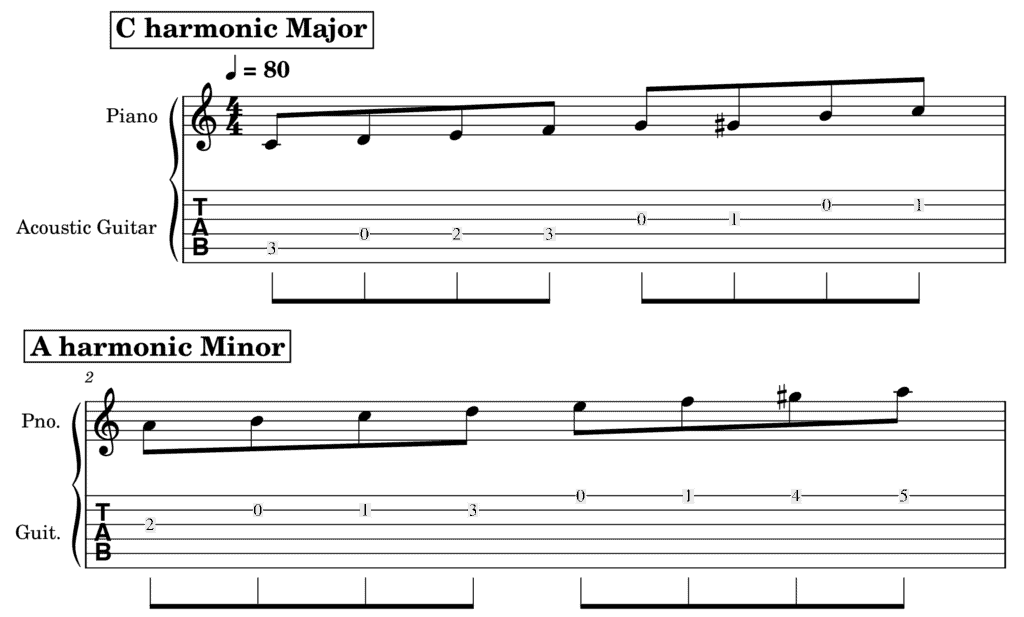Scales often scare beginners, but these things are fundamentals of music as a whole.
Scales are just musical patterns of notes that create a harmonic mood together.
Today we’ll look at the coolest ones.
Let’s look at some scales that are awesome and fun to learn, starting from the obvious ones:
- Pentatonic scale, major and minor
- Natural major scale
- Natural minor scale
- Blues scale
- Harmonic scale
- Melodic scale
All of these scales are similar, but their slight differences make for some interesting musical differences.
You might find by the end of this that music really has no set rules.
What are guitar scales?
Guitar scales are notes played in relationship to each other that create a specific tone based on their intervals.
The notes on a scale exist within precise harmonic intervals and relationships with each other that are pleasing to the ear.
Essentially, musical scales are just noises that we like that seem to fit together in a way that our brain enjoys. It’s all math, they’re just math.
How can guitar scales improve your playing?
Learning guitar scales is fundamental to making music.
You can’t make music without structure, because everything works in time and relationship.
Otherwise, you would be making noise, not music.
The point of music is that it’s got a structure to it.
So how does learning these scales make your playing better?
It makes making music less of a guessing game.
You can learn these scales that have been figured out and use them to make music more straightforward.
It also makes it easier to understand other people’s music.
For instance, if you know a song is played on the blue scales, that narrows down the notes you need to play.
Further, if you know it’s on the blues scale and it’s in the key of E, then you are even closer.
This makes it easier to learn and memorize songs because we can spend less time narrowing down the frequency and notes and just get to play on the patterns we know were used.
How to practice guitar scales effectively?
Scales are more than just memorization and ascending and descending the scale.
That’s at least important for the basics, but the way to practice scales is to implement them and to think about them.
When you’re learning scales, you should be looking to use them to create riffs.
I big part of playing music is the making of music and you can’t make what you don’t understand and you can only understand scales by using them in ways that are unique to you.
Scales aren’t as difficult to understand as they seem, in fact, most theory is easier to understand when it becomes implemented.
How much should you focus on practicing scales?
Well, I would say, learn scales and practice using them until it’s easy to remember them.
You should look to know their shapes on the neck and their patterns in relation to the frets, but beyond that, you could say that any time you’re playing lead, you’re implementing scales.
Now, rote practice or simply going up and down the scale is good for getting your fingers used to the pattern shape, but it won’t account for playing songs where the melody jumps over intervals.
So in short, practice the scale until you know it, then start using it.
6 best guitar scales to practice
1. Pentatonic scale, major and minor

A pentatonic scale is a scale with only 5 notes in it.
It takes out the half steps in the scale and only plays full steps and the full plus half steps. In other words, on guitar, if you play a pentatonic scale, you don’t play any steps where two frets are right next to each other:
The major and minor pentatonic are very similar, the only thing you have to remember is the starting point.
The minor starts on the sixth of the major, so the pattern will be a little bit different.
The reason I recommend the pentatonic is because it’s easier to learn as a beginner.
Sometimes you might forget where the half step is, but with pentatonic that’s not much of an issue.
2. Natural major scale

The natural major scale is what we know simply as the major scale. This scale has a bright tone to it when you play it.
This could somewhat be attributed to those half steps, namely the minor 3rd and diminished 7th.
3. Natural minor scale

The minor scale is similar to the major scale, but it has a slightly different pattern to it.
It’s easy to remember if you remember that the natural minor scale starts on the 6th degree of the major scale.
4. Blues scale

The blues scale is one step up from the natural scales in that it’s similar to the pentatonic, but it adds one extra note, known as the blues note.
You’ll find this scale fits in right at home with rock and roll music.
Most commonly, the minor blues scale is played, for example, the A minor blues scale.
But there also exists the major blues scale with a slight variation in how it’s played. It’s also been called the gospel scale because of how bright it sounds.
You’ll note that the A minor blues scale is the same as the C major blues scale and that’s because relative scales still apply within the blues scale.
If you’re not sure how relative scales work, I’ve written a post on that too
5. Harmonic scale

The harmonic scale is the next step up in scale sophistication. I personally love this scale, it gives a very fragile tone to the notes.
It sounds like playing on porcelain.
There are key differences between the minor and major harmonic scales though.
For instance, the C harmonic major doesn’t have an A note in it, the A is flattened in the harmonic major.
You’ll find in A harmonic minor, many of the notes are the same as the A minor scale, except the 7th degree is raised. In this case, G becomes G#.
So there aren’t likely relative major and minor scales because the difference is that C major harmonic has a G note, but no A note.
Whereas A minor harmonic has the A but no G.
6. Melodic minor scale

And now we get to a scale that varies depending on whether it’s ascending or descending.
The melodic scale is also a beautiful bit of sophistication, but it’s a little trickier than the other scales because depending on the direction you’re traveling on it, you have to remember almost two scales.
It looks like this in the C melodic minor:
Recommended guitar scale practice routine
So, some great practice routines are to not just ascend and descend the scale but to use the notes in intervals to each other.
For instance, using a scale to play an ascending diatonic melody using the 6th interval from your root note, like so:

You can do this with the third, fourth and fifth as well, although I like the 6th because of how pleasant it sounds.
Secondly, you can do triadic scale movements.

For instance, if you were playing on the C major scale, you can play the c major triad in triplets, ascending to the D minor, E minor, and so on.
This exercise is great for on-the-fly melodic improv, especially for following the rhythm guitar.
Last is using broken thirds


Hello there, my name is Ramiro and I’ve been playing guitar for almost 20 years. I’m obsessed with everything gear-related and I thought it might be worth sharing it. From guitars, pedals, amps, and synths to studio gear and production tips, I hope you find what I post here useful, and I’ll try my best to keep it entertaining also.





